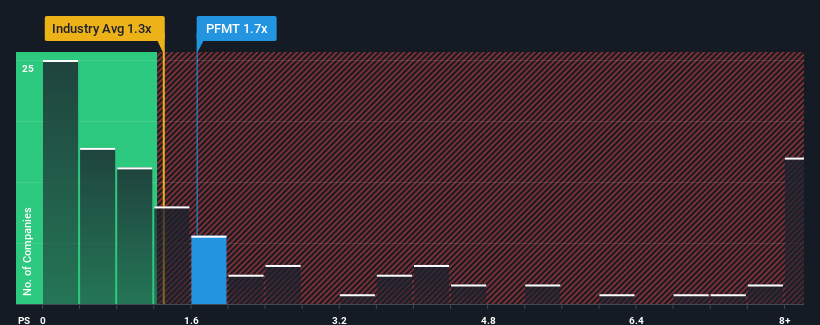- United States
- /
- Healthcare Services
- /
- NasdaqGS:PHLT
Investors Aren't Entirely Convinced By Performant Financial Corporation's (NASDAQ:PFMT) Revenues
There wouldn't be many who think Performant Financial Corporation's (NASDAQ:PFMT) price-to-sales (or "P/S") ratio of 1.7x is worth a mention when the median P/S for the Commercial Services industry in the United States is similar at about 1.3x. However, investors might be overlooking a clear opportunity or potential setback if there is no rational basis for the P/S.
Check out our latest analysis for Performant Financial

What Does Performant Financial's Recent Performance Look Like?
With revenue growth that's inferior to most other companies of late, Performant Financial has been relatively sluggish. It might be that many expect the uninspiring revenue performance to strengthen positively, which has kept the P/S ratio from falling. If not, then existing shareholders may be a little nervous about the viability of the share price.
Want the full picture on analyst estimates for the company? Then our free report on Performant Financial will help you uncover what's on the horizon.How Is Performant Financial's Revenue Growth Trending?
There's an inherent assumption that a company should be matching the industry for P/S ratios like Performant Financial's to be considered reasonable.
Retrospectively, the last year delivered a decent 4.2% gain to the company's revenues. However, this wasn't enough as the latest three year period has seen an unpleasant 27% overall drop in revenue. Therefore, it's fair to say the revenue growth recently has been undesirable for the company.
Looking ahead now, revenue is anticipated to climb by 11% during the coming year according to the dual analysts following the company. Meanwhile, the rest of the industry is forecast to only expand by 8.4%, which is noticeably less attractive.
With this in consideration, we find it intriguing that Performant Financial's P/S is closely matching its industry peers. Apparently some shareholders are skeptical of the forecasts and have been accepting lower selling prices.
What Does Performant Financial's P/S Mean For Investors?
Generally, our preference is to limit the use of the price-to-sales ratio to establishing what the market thinks about the overall health of a company.
Looking at Performant Financial's analyst forecasts revealed that its superior revenue outlook isn't giving the boost to its P/S that we would've expected. Perhaps uncertainty in the revenue forecasts are what's keeping the P/S ratio consistent with the rest of the industry. It appears some are indeed anticipating revenue instability, because these conditions should normally provide a boost to the share price.
Many other vital risk factors can be found on the company's balance sheet. Our free balance sheet analysis for Performant Financial with six simple checks will allow you to discover any risks that could be an issue.
If these risks are making you reconsider your opinion on Performant Financial, explore our interactive list of high quality stocks to get an idea of what else is out there.
New: Manage All Your Stock Portfolios in One Place
We've created the ultimate portfolio companion for stock investors, and it's free.
• Connect an unlimited number of Portfolios and see your total in one currency
• Be alerted to new Warning Signs or Risks via email or mobile
• Track the Fair Value of your stocks
Have feedback on this article? Concerned about the content? Get in touch with us directly. Alternatively, email editorial-team (at) simplywallst.com.
This article by Simply Wall St is general in nature. We provide commentary based on historical data and analyst forecasts only using an unbiased methodology and our articles are not intended to be financial advice. It does not constitute a recommendation to buy or sell any stock, and does not take account of your objectives, or your financial situation. We aim to bring you long-term focused analysis driven by fundamental data. Note that our analysis may not factor in the latest price-sensitive company announcements or qualitative material. Simply Wall St has no position in any stocks mentioned.
About NasdaqGS:PHLT
Performant Healthcare
Provides audit, recovery, and analytics services in the United States.
Excellent balance sheet with moderate growth potential.
Similar Companies
Market Insights
Community Narratives


Recently Updated Narratives


MINISO's fair value is projected at 26.69 with an anticipated PE ratio shift of 20x


The Quiet Giant That Became AI’s Power Grid


Nova Ljubljanska Banka d.d will expect a 11.2% revenue boost driving future growth
Popular Narratives


The company that turned a verb into a global necessity and basically runs the modern internet, digital ads, smartphones, maps, and AI.


MicroVision will explode future revenue by 380.37% with a vision towards success



